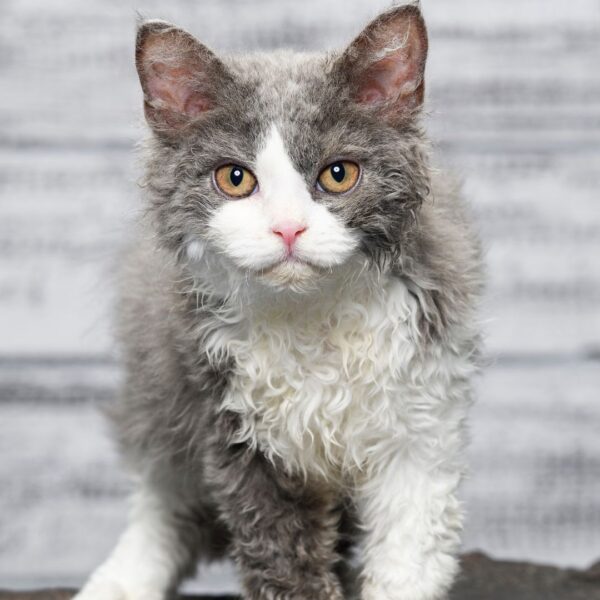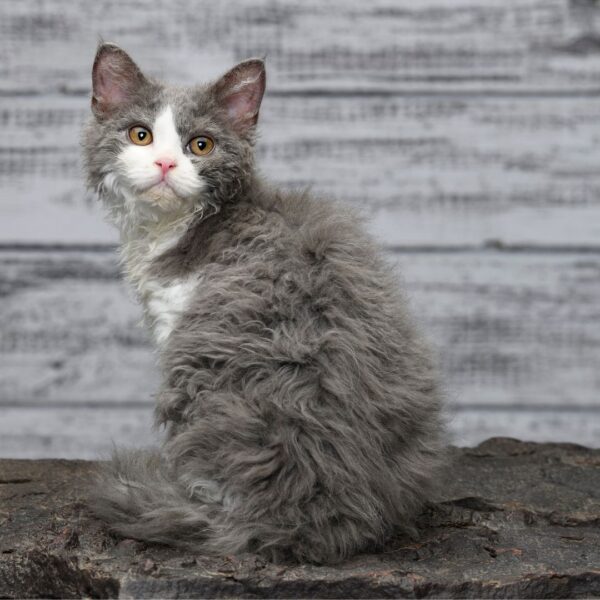
Curly Cat Whiskers:
Curly cat whiskers are relatively uncommon but can be a distinctive characteristic of some feline breeds, most notably the Cornish Rex. These whiskers, or vibrissae, are an essential part of a cat’s sensory system, playing a significant role in spatial navigation and environmental interaction. Unlike the straight whiskers found in most cats, curly whiskers can sometimes appear broken or shorter due to their shape. While this is a natural trait for some breeds, it’s crucial to understand that whiskers are deeply rooted and highly sensitive, and should be treated with care regardless of their appearance.
When caring for cats with curly whiskers, it’s important to recognize that these special vibrissae serve the same purpose as straight whiskers. They help gauge the width of openings, detect changes in their surroundings, and can even be indicative of a cat’s mood. Given their significance, curly whiskers should not be trimmed or altered, as this can affect a cat’s ability to navigate and may cause stress or disorientation. Whiskers are an essential aspect of feline anatomy, and maintaining their health is critical to a cat’s well-being.
Key Takeaways
- Whiskers provide essential sensory information for navigation and environmental perception.
- Curly whiskers in cats should not be trimmed, as they are integral to feline spatial awareness.
- Maintaining the health of a cat’s whiskers, curly or straight, is vital to their overall well-being.

Curly Whiskers in Cats
Curly whiskers in cats, often a distinctive trait of certain breeds, have intrigued feline enthusiasts and researchers alike. This unique characteristic can be influenced by genetics, health, environmental factors, and age.
A Sign of Breed
Curly whiskers in cats are commonly associated with particular breeds that possess a natural mutation for this trait. The Devon Rex and Cornish Rex, each identified by their curly coats, also display this feature in their whiskers due to a genetic attribute. Similarly, the Selkirk Rex is recognized for its whiskers that curl distinctively from birth. The LaPerm is another breed identified by its curly whiskers, complementing its curly coat.
Health and Genetics
The genetics behind curly cat whiskers is not commonly associated with health issues. A genetic variant in the LPAR6 gene is known to cause the curly hair and whiskers in breeds such as the Cornish Rex. It is always advisable for cat owners to consult with a veterinarian if there are concerns about abnormalities in a cat’s whiskers, which are vital sensory tools.
Environmental and Behavioral Influence
Certain environmental and behavioral factors can lead to a temporary curling of cat whiskers. Repeated stress on the whiskers from activities like frequent rubbing or resting in specific positions can lead to noticeable bends. However, such curling resulting from repetitive pressure tends to be temporary and does not genetically predispose the cat to have naturally curly whiskers.
Age-Related Changes
As cats age, changes in their whiskers may occur, including curling. Aging can influence the stiffness and structure of whiskers, leading them to appear more curled or bent. Nevertheless, senior cats with naturally straight whiskers should not experience significant curling akin to the above-mentioned Rex breeds. Additionally, these age-related changes do not typically affect the cat’s inherent ability to detect changes in air currents, a key whisker function.

Caring for a Cat with Curly Whiskers
Cats with curly whiskers require vigilant care to ensure their unique sensory tools are not compromised. Close attention to their condition can reveal much about a cat’s well-being.
Regular Veterinary Check-Ups
Regular check-ups with a veterinarian are crucial for monitoring the health of a cat’s curly whiskers. Since whiskers are sensitive and can indicate a cat’s stress levels and overall mood, a professional can assess whether their curly nature is a benign trait or a sign of potential health issues. Cats’ whiskers, which are rigid tactile hairs called vibrissae, play a critical role in their spatial awareness and equilibrium. Age-related changes to their whiskers should also be evaluated during these visits.
Observing Whisker Changes
Observing any changes in a cat’s whiskers can provide insight into their health and stress levels. A change in the whiskers’ shape, such as increased curling or damage, can indicate discomfort or health problems. Cat parents should look for broken whiskers or changes in their texture. Whiskers should never be trimmed or altered, as this can cause disorientation and stress for the cat.
Ensuring Comfort and Safety
It’s essential to ensure a safe and comfortable environment for cats with curly whiskers. Their whiskers are sensitive sensory tools, and even naturally curly whiskers can become a source of discomfort if they frequently encounter obstacles. Cat parents should:
- Provide wide food and water bowls to prevent whisker discomfort.
- Keep their living space free from clutter to avoid whisker damage.
- Be mindful of the cat’s mood and behavior, as changes could indicate issues with their whiskers.
Cat parents must remember that whiskers are an integral part of a cat’s sensory apparatus and should protect them from harm.

Understanding Cat Whiskers
Cat whiskers are a vital sensory tool, infused with nerve cells at the base that help felines navigate their environment. These whiskers can sometimes exhibit a curl, which is part of their unique growth process.
Whisker Anatomy
Cat whiskers are comprised of keratin and are much thicker than regular cat fur. They are deeply embedded in the cat’s skin and connected to a muscular and nervous system that is highly sensitive. Each whisker is rooted in a follicle that is surrounded by a rich sensory system including a wealth of nerve cells. These nerves make whiskers incredibly sensitive to touch and air currents.
Whisker Function
Whiskers are a key sensory apparatus for cats. They are not merely hairs, but a critical part of a cat’s balance and touch receptors. Whiskers detect changes in their surroundings, allowing cats to sense obstacles and prey, measure openings, and respond to environmental stimuli. They can even perceive air currents, aiding in navigation.
Whisker Growth Cycle
Like other hairs, whiskers go through a growth cycle, where old whiskers fall out and new whiskers grow back. This cycle is not indicative of a cat’s age, as it happens throughout a cat’s life. The growth, replacement, and even the unique curl of some whiskers occur naturally. The presence of curly whiskers in some breeds shows variances in the standard formation and could be purely a genetic trait.
Whisker Health and Issues
Whisker health is crucial for a cat’s spatial awareness and mood. Issues ranging from whisker fatigue to physical damage can lead to discomfort and health problems.
Cat Whisker Fatigue
Whisker fatigue occurs when a cat’s sensitive whiskers become overstimulated, leading to signs of stress and discomfort. This often results from their whiskers constantly touching surfaces around them. To prevent fatigue, owners should provide wide food dishes that prevent whiskers from touching the sides during feeding.
Physical Damage to Whiskers
Whiskers can suffer physical damage through accidents, fights, or rough handling. Damaged whiskers might appear broken, split, or abnormally curled. Such damage can cause pain and affect the cat’s ability to navigate. Regularly checking a cat’s whiskers for signs of damage and avoiding trimming or pulling them is essential for their well-being.
Whisker Disorders
Cats may experience whisker disorders such as:
- Folliculitis: This is an infection of the hair follicles that can cause pain and swelling. If infected, whisker follicles may lead to loss or damage of the whiskers.
- Hormonal Imbalances: Certain hormonal imbalances can lead to abnormal whisker growth or loss.
- Genetic Conditions: Some breeds may inherently have curly whiskers that do not mean any health issue. However, a sudden change in texture might indicate a problem.
Observing a cat’s behavior and consulting a veterinarian for any abnormalities is the best course of action to maintain whisker health.
Summary of Curly cat whiskers
- Why do some cats have curly whiskers?
Some cat breeds, such as the Devon Rex and the Cornish Rex, naturally have curly whiskers due to their unique genetic makeup. The American Wirehair also displays this trait. It’s simply a part of their breed characteristics. - Do curly whiskers affect a cat’s sense of touch?
Whiskers are highly sensitive tactile hairs called vibrissae, which cats use to detect changes in their environment. Curly whiskers still perform this function, though the shape may slightly alter the way the cat perceives nearby objects or movements. - Can all cat whiskers curl?
Typically, straight whiskers do not curl naturally. However, environmental factors or damage can cause temporary kinks or curls in otherwise straight whiskers. - Is it okay to trim a cat’s whiskers?
No, one should never trim a cat’s whiskers. They are essential for a cat’s spatial awareness and ability to navigate its surroundings. Cutting them can disorient and stress a cat. - How should I care for my cat’s curly whiskers?
There is no special care required for curly whiskers. They should be left intact and not manipulated, as they are as functional and important as straight whiskers.

Frequently Asked Questions about Curly cat whiskers
In exploring the curvature of feline whiskers, it becomes evident that both genetic and environmental factors may influence their shape. These FAQs address common curiosities and concerns regarding curly whiskers in cats.
What causes a cat’s whiskers to curl forward?
The curling forward of a cat’s whiskers is typically a natural genetic trait, not indicative of any underlying health problems. Certain breeds, like the Devon Rex and the American Wirehair, are known for their distinctly curly whiskers.
What can lead to a cat having one or more curly whiskers?
Aside from genetics, a cat may have one or more curly whiskers due to minor whisker damage. This could happen as a result of the cat’s environment, such as navigating through tight spaces or playing roughly, causing temporary changes in the whiskers’ shape.
Could there be a health issue causing my kitten’s whiskers to curl?
Generally, curly whiskers in a kitten are not a sign of a health issue, particularly if the breed is known for this trait. If the curling appears suddenly and is accompanied by other symptoms, a veterinary check-up might be prudent.
Is it normal for a cat’s whiskers to appear burnt or to actually be burnt?
It is not normal for a cat’s whiskers to be burnt. If a cat’s whiskers appear singed or damaged by heat, this could point to an unsafe environment or accidental exposure to heat sources. Care should be taken to keep cats away from potential hazards.
How should you deal with whiskers curling into a cat’s eyes?
If a cat’s whiskers are curling into its eyes and causing discomfort, it’s best to consult with a veterinarian. Trimming whiskers is not recommended as they are essential for a cat’s spatial awareness and should be left to grow naturally.
What are the characteristics of whiskers from different cat breeds?
Different cat breeds exhibit distinct whisker characteristics. The Devon Rex, for example, has short, curly whiskers, while many other breeds have long, straight whiskers. Breed-specific genetics play a significant role in determining whisker shape and texture.